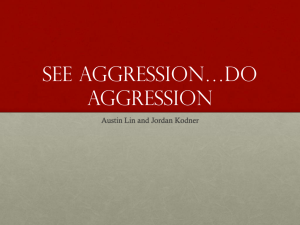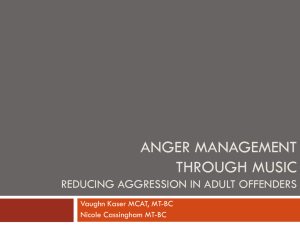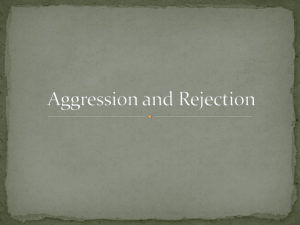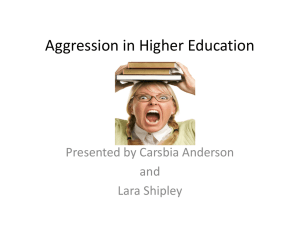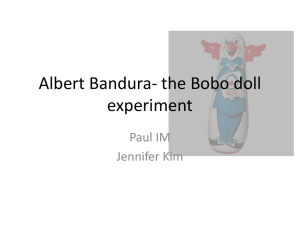Discussing the management of aggression and violence
advertisement
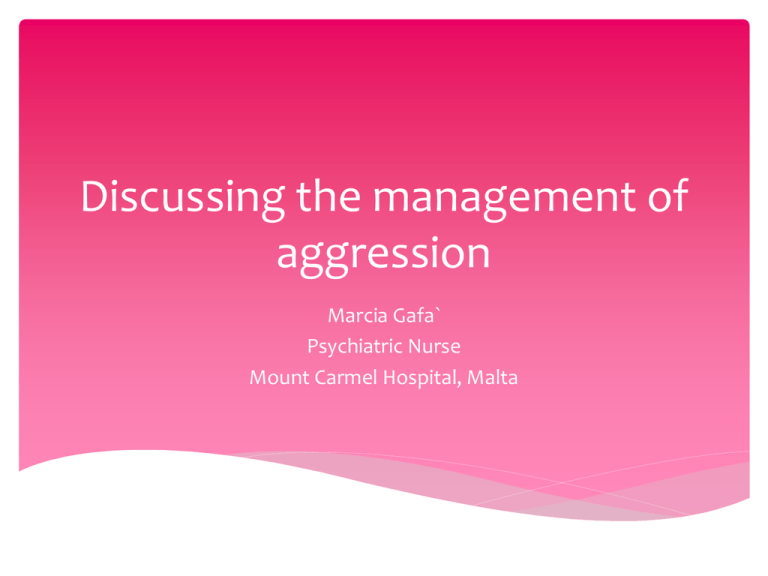
Discussing the management of aggression Marcia Gafa` Psychiatric Nurse Mount Carmel Hospital, Malta Background Hospital perspective Overview of the some of the methods used to manage aggression within the context of the hospital Who’s the aggressive patient? Aggressive patients can be defines as those displaying the following behaviours: Verbal and/or physical aggression against staff and/or other patients and/or visitors Physical aggression towards self or against objects (both lethal and non-lethal) Exhibiting high risk behaviours Why manage aggression? Management of acutely disturbed individuals in an in-patient setting poses a particular challenge. Some patients may be actively suicidal, or actively interested in harming themselves or others around them, may be over-stimulated by the ward environment, may be actively psychotic, pose a risk of absconding, confused, sexually disinhibited etc… The greatest challenge is to maintain safety and harmony whilst providing safe and therapeutic environments. Muralidharan & Fenton, (2006) Choice of managing aggression Safety for ourselves; Safety to self or others (others patients feel threatened); Control over the situation; The hospital is a place of care not a place where aggression is permitted However, if aggression threatens the well-being and safety of others why is a person nursed within a psychiatric context? Foster et al., (2006) Clinical perspective It’s a highly personalised subject, little agreement and a lot of debate. Is managed in a psychiatric setting based on: Previous history Present during admission Psychopathology of illness/diagnosis Age Assessment Involuntary admissions to hospital Ward/hospital culture Bowers et al., (2009) Types of management Seclusion Restraint PRN medication De-escalation Alternative therapies Seclusion & Restraint [S&R] S&R are both highly restrictive interventions Seclusion involves the placement of a patient alone in a locked room from which s/he can’t freely exit. This coercive measure is used frequently after an aggressive outburst Decisions for seclusion: Containment of individual; Isolation; To reduce sensory stimuli. Restraint has the intent to control an aggressive patient whilst restore the safety of the ward environment. It should be implemented as the last resort, when other options have failed. Nevertheless this method could be traumatic for the patient and staff, effecting the therapeutic relationship (which is paramount within the mental health field), perceived as punishment for their actions, profound distressing, and may reduce patients for seeking help once out of the hospital. NICE, (2005), Stubbs & Dickens, (2008) Their use! A reliance on restrictive interventions could be a result of: Lack of policies and guidelines within a given organisation; Burden to administration; Limited human resources; Staff perspective such as burnout or fear; No other options. Vruwink et al., (2012) PRN/Pharmacological intervention Often used at the nurse’s discretion to help manage aggression and agitation within the ward environment. Most common form of PRN medication would be: Benzodiazepines (p.o./i.m./i.v.) Antipsychotics Anti histamines Sedatives Ideally nurses base their decision to administer a PRN medication based on sound clinical judgement. However, one can not underestimate the powerful influence of the ward/organisational culture and how that influences the nurse’s decision making. Lack of organisational criteria, lack of professional knowledge and experience (effect of drug), lack of human resources all influence the use PRN medication. Usher et al., (2003) Safer alternatives! Comprehensive Assessment – if the opportunity allows for it! Done within the first 24 hours Use of risk assessment tools In agreement with the person Characteristics that may indicate aggression Identify short term goals to control aggression - de-escalation Other options if these fail Long-term goals for management of aggression – alternative therapies Donat., (2005); Jayaram et al., (2012); Jonikas et al., (2004) De-escalation A gradual resolution of a potentially violent and/or aggressive situation through the use of verbal and physical expression of empathy, alliance and nonconfrontational limit setting that is based on respect. In a simpler explanation, de-escalation is defusing using communication and the therapeutic relationship Stubbs & Dickens, (2008) Some of the techniques include: Observation for signs of agitation leading to aggression Teaching self to remain calm to help control the situation Using distraction techniques Verbal techniques Withdrawing the person of the situation Removing stimulation Using the therapeutic relationship Muralidharan & Fention, (2006); Stubbs & Dickens, (2008) However, de-escalation is not a standardised programme taught to professionals: may include breakaway techniques and physical restraint in training thus clouding the effectiveness of solely using de-escalation to diffuse the aggression. While training programmes are renowned for reducing aggression, negatives outcomes can be attributed to an increase of physical restraint as staff would feel more confident to confront aggression after training Livingston et al., (2010) Yet staff training program install a sense of group cohesion and working as a collective group may reduce aggression. Therefore rather it being training which reduces aggressive incidents in wards, it would be a cultural bond of staff supporting each other and patients which reduces aggression. Also de-escalation needs to be supported by the organization and it’s implementation has to be culturally driven! Livingston et al., (2010) Alternative therapies In response to most training programmes relying upon the medical model, i.e. control and restraint, alternative therapies focus on the patient. Can range from talks with the professional to behavioural contracts and behavioural modification programmes such as anger management Effectiveness: alternative therapies allow the patient have control over the situation and deal with their aggression. Nevertheless these are time consuming, individual desire and require a period of time for adjustment. Requires support and follow-up: Staff to patient Management to staff (ongoing training) Changing polices and organisational agenda. In conclusion S&R should be used as the last resort PRN may have negative effects such as drowsiness The above methods are effective when no other options are available De-escalation is effective at the right opportunity Alternative therapies may take time but do help change behaviour, thus reduce aggression. References Bowers, L., Allan, T., Simpson, A., Jones, J., M, & Jeffery, D. (2009). Identifying key factors associated with aggression on acute inpatient psychiatric wards. Issues in Mental Health Nursing, 30(4), 260-271. doi: 10.1080/01612840802710829 Donat, D. C. (2005). Encouraging alternatives to seclusion, restraint, and reliance on PRN drugs in a public psychiatric hospital. Psychiatric Services, 56(9), 1105-1108. Foster, C., Bowers, L., & Nijman, H. (2007). Aggressive behaviour on acute psychiatric wards: Prevalence, severity and management. Journal of Advanced Nursing, 58(2), 140-149. Janikas, J. A., Cook, J. A., Rosen, C., & Laris Alexandra, K. J. (2004). A program to reduce use of physical restraint in psychiatric inpatient facilities. Psychiatric Services, 55(7), 818-821. Jayaram, G., Samuels, J., & Konrad, S. (2012). Prediction and prevention of aggression and comprehensive seclusion documentation. Innovations in Clinical Neuroscience, 9(7-8), 30-38. Livingston, J. D., Verdun-Jones, S., Brink, J., Lussier, P., & Nicholls, T. (2010). A narrative review of the effectiveness of aggression management training programs for psychiatric hospital staff. Journal of Forensic Nursing, 6(1), 15-28. doi: 10.1111/j.1939-3938.2009.01061.x Muralidharan, S., & Fenton, M. (2006). Containment strategies for people with serious mental illness. Cochrane Database of Systematic Reviews (Online), (3), CD002084. Stubbs, B., & Dickens, G. (2008). Prevention and management of aggression in mental health: An interdisciplinary discussion. International Journal of Therapy & Rehabilitation, 15(8), 351-356. Vruwink, F., J., Noorthoorn, E., O., Nijman, H., L.I., VanDerNagel, J., E.L., Hox, J., J., & Mulder, C., L. (2012). Determinants of seclusion after aggression in psychiatric inpatients. Archives of Psychiatric Nursing, 26(4), 307-315. doi: 10.1016/j.apnu.2011.10.004


